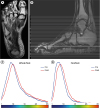Figures and Tables
Figure 1
(A) Clinical photograph shows dry gangrene at the distal half of the toe. (B) Preprocedural time-of-flight magnetic resonance angiography image showing absent anterior tibial artery (ATA) flow. Abnormal arterial waveform was noted in 3 major arteries on phase-contrast blood velocity mapping (yellow line, ATA; orange line, posterior tibial artery [PTA]; green line, peroneal artery [PA]). (C) Digital subtraction angiography image showing no contrast filling along the dorsalis pedis artery. (D) Preprocedural T2* perfusion map of the patient's foot.

Figure 2
(A) Clinical photograph after endovascular treatment. (B) Postprocedural time-of-flight magnetic resonance angiography image demonstrating restored anterior tibial artery (ATA) and dorsalis pedis artery flow. The phase-contrast blood velocity map shows improved mean flux and mean velocity of the ATA with improved arterial waveform. (C) After endovascular treatment, flow at the ATA and dorsalis pedis artery was restored. Note the presence of lateral tarsal and dorsal metatarsal arteries. (D) Postprocedural T2* perfusion map. Compared with preprocedural findings, the T2* value increased at the intrinsic foot muscles (long arrows) and soft tissues at the level of the first proximal phalanx and lateral foot border (white arrowheads). Note that the T2* signal intensity in the distal phalangeal area remained low (red arrowheads).

Figure 3
(A) T2-weighted axial image used as a reference image for interpretation. (B) The level of the axial image for Figures 1D, 2D, and 3A noted on the sagittal scout image. (C) Histogram of the T2* value of the whole foot, depicted using all T2* values obtained from 15 axial cuts of blood oxygenation level-dependent magnetic resonance images of the foot (slice number 15–29 on Figure 3B). Note that the histogram shifted to the right after endovascular therapy (blue parabola, preprocedural image; red parabola, postprocedural image). (D) Histogram of the T2* value of the forefoot. The forefoot was segmented using the proximal point of the metatarsal bones as a cutoff point.

Notes
Author Contributions
Conceptualization: Lee PH, Lee SW, Lee WJ, Shin MJ.
Data curation: Lee PH, Lee SW.
Formal analysis: Lee JY, Kang JW.
Funding acquisition: Lee PH.
Investigation: Lee PH, Shin MJ.
Methodology: Lee PH, Lee SW, Lee WJ, Kang JW, Shin MJ.
Supervision: Lee PH, Lee SW, Shin MJ.
Validation: Lee PH, Lee JY, Lee SW, Lee WJ, Kang JW, Shin MJ.
Writing - original draft: Lee JY.
Writing - review & editing: Lee PH.




 PDF
PDF ePub
ePub Citation
Citation Print
Print



 XML Download
XML Download